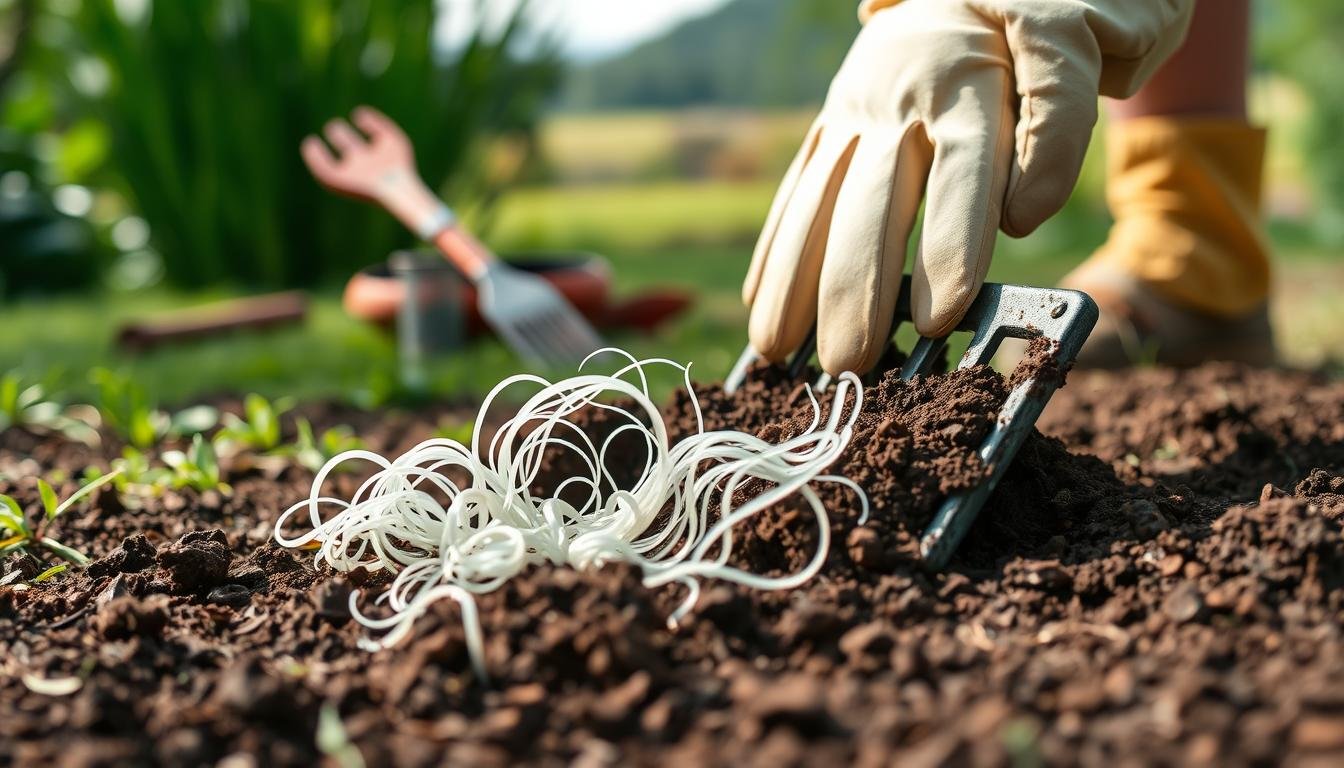Whipworms in your yard are a big problem for pet owners. These tough parasites hide in the soil, ready to infect pets. They can turn your outdoor area into a health danger for dogs and even people.
I’ve put together a detailed guide to fight these parasites. You’ll learn about natural treatments and cleaning strategies. Follow these seven steps to keep your yard safe for your pets and prevent infections.

Understanding Whipworm Infestation in Your Yard
Whipworms can turn your yard into a health risk for your pets. These tiny parasites are hard to manage. Knowing how they spread is key to keeping your yard safe.
What Are Whipworms and Their Life Cycle
Whipworms are small worms with a whip-like shape. They attach to the intestines of animals. Their life cycle starts when eggs are laid in soil from infected animals.
- Microscopic size: Less than 2-3 inches long
- Survival time in soil: Up to 5 years
- Transmission method: Oral ingestion of contaminated soil
Common Signs of Yard Contamination
Finding whipworms is hard. Pets might lose weight, have diarrhea, or feel tired. They often have belly pain and trouble absorbing nutrients.
How Whipworms Spread in Outdoor Spaces
Whipworms thrive in damp, shaded areas. They spread through soil, animal waste, and shared spaces. Dogs and wild animals can carry them, making yards a risk.
- Primary transmission routes: Fecal matter
- High-risk environments: Damp, shaded areas
- Potential carriers: Dogs, foxes, coyotes
Why Immediate Action is Crucial for Yard Treatment
Whipworm infestations can quickly become a serious threat to your yard and pet health. Delaying treatment can lead to devastating consequences for both animals and humans. These parasitic worms multiply rapidly, creating a dangerous environment that requires immediate intervention.
The risks of ignoring a whipworm problem are significant. Whipworm larvae control becomes critical because these parasites can cause severe health issues. This includes:
- Chronic digestive problems for pets
- Potential transmission to human family members
- Rapid contamination of outdoor spaces
- Long-term damage to soil ecosystem
I recommend acting quickly to prevent widespread infestation. The longer you wait, the more challenging elimination becomes. Prompt treatment reduces health risks and minimizes environmental impact. Each day of delay allows these parasites to establish deeper roots in your yard’s ecosystem.
Veterinarians and pest control experts agree that swift action is the most effective strategy. By addressing the problem immediately, you can protect your pets, family, and outdoor living spaces from long-term damage.
Essential Safety Measures Before Starting Treatment
Dealing with a whipworm infestation needs careful planning and safety steps. I’ll show you how to keep yourself, pets, and your yard safe during treatment.
Personal Protection Equipment Needed
When fighting whipworm, wearing the right gear is key. Your safety kit should have:
- Durable rubber or disposable gloves
- Closed-toe boots or work shoes
- Long-sleeved shirts
- Long pants
- Optional: Protective eyewear and face mask
Preparing Your Yard for Treatment
Getting your yard ready for treatment means cleaning and isolating dirty spots. First, remove animal waste, dead leaves, and debris that might hide whipworm eggs.
| Preparation Step | Purpose |
|---|---|
| Remove animal feces | Eliminate possible egg sources |
| Clear debris | Reduce places for parasites to hide |
| Isolate affected areas | Stop the infestation from spreading |
Protecting Pets During the Process
Keeping pets safe is very important when using natural treatments. Move pets away from treated areas to avoid exposure. Keep them out until the area is safe and the treatment is fully absorbed.
Always wash your hands well after touching contaminated soil or finishing yard treatment. This step helps stop the spread of whipworm eggs to people or animals.
How to Get Whipworms Out of Yard
Dealing with whipworms in your yard needs a solid plan. I’ll share the best ways to remove whipworm eggs and get rid of soil parasites. This will help you make your yard healthy again.

To get rid of whipworms, you must use several methods. Here are the main steps to fight these tough parasites:
- Maintain strict yard hygiene by removing pet feces immediately
- Apply lime to destroy whipworm eggs in soil
- Consider soil replacement for severe infestations
- Use natural treatments like diatomaceous earth
- Disinfect hard surfaces with bleach
- Install fencing to prevent stray animal access
For effective whipworm removal, a multi-step plan is best. Start with regular cleaning. Remove pet waste quickly and keep the grass short to stop egg spread. Always wear gloves when cleaning to avoid touching eggs.
Chemical and natural treatments are key for soil parasite control. Lime can dry out and kill eggs, and diatomaceous earth is a safe, non-toxic option. For a deep clean, replace the top six inches of soil with fresh earth.
Remember to talk to your vet if you think your pets have whipworms. A vet’s advice is vital for treating your pets and stopping the parasite spread.
Natural Methods for Eliminating Whipworms
Dealing with whipworms in your yard needs a smart plan that focuses on organic methods. I’ve found several green ways to fight these pests without using harsh chemicals.
Organic treatments are a safe and green way to tackle whipworm problems. These methods are often used by neighbors and can greatly cut down on these pests.
Soil Solarization Technique
Soil solarization is a top natural method. It uses sunlight to kill whipworm eggs and larvae. Here’s how to do it:
- Clear the area of debris and plants
- Moisten the soil well
- Cover it with clear plastic sheeting
- Seal the plastic edges to trap heat
- Keep it covered for 4-6 weeks in summer
Organic Treatment Solutions
I suggest several natural ways to control whipworms:
- Use diatomaceous earth
- Apply beneficial nematodes
- Keep your yard clean
- Ensure good drainage to reduce moisture
Success with organic whipworm control comes from being consistent and patient. These natural methods might take longer than chemicals. But they’re safer for pets and kids and work well to manage the problem.
Chemical Treatment Options for Yard Sanitization
When natural methods don’t work, chemical treatments are key for yard cleaning. EPA-registered pesticides are strong against whipworm eggs. They stop these eggs from spreading in your yard.
Choosing the right chemical is important. Check the EPA’s pesticide database for products against whipworms. Professional chemicals can fight these pests well while being kind to the environment.
- Select EPA-approved pesticides with proven effectiveness against whipworms
- Apply natural chemical treatments targeting specific yard areas
- Follow precise application guidelines for maximum efficacy
Keeping safe is a must when cleaning your yard. Wear the right gear and follow the instructions. Local extension services can give advice on treatments for your area.
| Chemical Treatment Type | Effectiveness | Application Method |
|---|---|---|
| Organophosphate Pesticides | High | Broad yard coverage |
| Pyrethrins-based Solutions | Moderate | Targeted spot treatment |
| Botanical Insecticides | Low-Moderate | Environmentally friendly option |
If your yard problem is tough, get help from pest control pros. They have the skills and tools for a deep clean.
Maintaining a Whipworm-Free Environment
To keep your yard free from whipworms, you need to work hard and plan well. It’s tough to stop whipworms from getting into your yard. But, with the right steps, you can make your outdoor area safe for pets and family.
Stopping whipworms from taking over your yard is about more than one thing. It’s about making a plan that covers both now and the future of your yard’s health.
Essential Yard Maintenance Strategies
- Remove pet waste right away to stop whipworm eggs from spreading
- Keep the grass short to cut down on moisture and places for parasites
- Regularly rake and clean up yard debris
- Make sure your yard drains well to avoid damp spots
Preventive Protection Techniques
- Take your pets for monthly vet visits
- Use monthly deworming treatments
- Do yard sanitation treatments often
- Stay away from areas that might have whipworms
I suggest making a regular yard care plan. Whipworms can stick around if you don’t manage them well. By following these steps, you’ll lower the chance of them coming back and keep your yard safe.
Prevention is better than treatment. Be active, keep things clean, and talk to vets to keep your yard free from whipworms.
Pet Care and Deworming Protocols
Keeping your pets safe from whipworms needs a solid deworming plan. Deworming is key to stop parasitic infections that harm animal health. The right plan depends on your pet’s age, lifestyle, and where they live.
It’s smart to work with your vet to make a deworming plan just for your pet. Pets are different, and a vet can tailor the best plan for them. Here are some key steps for deworming pets:
- Schedule monthly preventative treatments
- Use veterinarian-prescribed heartworm medications
- Conduct regular fecal examinations
- Maintain a clean living environment
Most heartworm meds also protect against whipworms and other parasites. These monthly treatments work well for dogs and cats. They keep your pets safe from many intestinal parasites.
Your pet’s deworming plan will depend on a few important things:
- Age of the pet
- Geographic location
- Outdoor exposure
- Overall health condition
Regular vet visits and deworming are key to fight off whipworms. By taking care of your pet’s health and your yard, you can keep both safe from these pests.
Common Mistakes to Avoid During Treatment
Treating a yard for whipworms needs careful attention. Many homeowners make mistakes that can ruin their treatment. Knowing these mistakes can help you protect your outdoor spaces better.
When dealing with whipworms, several mistakes can stop your treatment:
- Incomplete medication protocols
- Ignoring environmental conditions
- Inconsistent treatment application
- Neglecting yard sanitation
Timing and Application Errors
Timing is key in treating whipworms. Not following the treatment schedule can let parasites come back. Treatments that are not regular or complete often fail.
Environmental Considerations
Whipworms need certain conditions to survive. Moisture and temperature affect their growth. Ignoring these can lead to ongoing problems. Larvae can stay in soil for a long time, so thorough treatment is needed.
- Monitor soil moisture carefully
- Understand temperature impacts on larvae survival
- Use complete treatment methods
- Keep up with yard maintenance
Avoiding these mistakes can help you get rid of whipworms in your yard. It also helps prevent them from coming back.
Conclusion
To get rid of whipworms in your yard, you need a solid plan. It’s important to know how these pests live and how to keep your pets safe. This means using a mix of strategies to fight them off.
Getting rid of whipworms isn’t a one-time job. It’s about keeping your yard safe all the time. You can use natural treatments or chemicals to help. Each method is important for keeping your yard free of whipworms.
Getting help from a vet is essential. They can guide you on how to keep your pets healthy. Regular vet visits, the right medicines, and keeping your yard clean are key. These steps help prevent whipworms from coming back.
Don’t give up. Keeping your yard clean and watching for problems is important. Stay alert and keep your pets safe. This way, you can protect their health and well-being.


